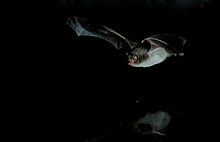- Long-fingered Bat
-
Long-Fingered Bat 
Conservation status Scientific classification Kingdom: Animalia Phylum: Chordata Class: Mammalia Order: Chiroptera Family: Vespertilionidae Genus: Myotis Species: M. capaccinii Binomial name Myotis capaccinii
Bonaparte, 1837
The Long-Fingered Bat (Myotis capaccinii) is a species of vesper bat in the family Vespertilionidae. It is known from Morocco, Algeria, southern Europe and the Middle East as far east as western Iran.
Contents
Physical characteristics
The bat is medium sized for a member of the Vespertilionidae family, with large feet and more prominent nostrils than other European Myotis species. Hair is dark grey at the base, with light smokey grey dorsal-side hair and light grey ventral-side hair.
Habitat
M. capaccinii lives in limestone areas, preferably wooded or shrubby terrain near flowing water. Summer and winter roosts are always in caves.
Reproduction
Little is known about this species reproductive cycle. Nursery roosts are in caves, with up to 500 females in clusters on the cave roof. Birth occurs in mid to late June, with only one young born.
References
- Schober, Wilfried; Eckard Grimmberger (1989). Dr. Robert E. Stebbings. ed (in English). A Guide to Bats of Britain and Europe (1st ed.). UK: Hamlyn Publishing Group. ISBN 0-600-56424-x.
Source
- "Myotis capaccinii". IUCN Red List of Threatened Species. Version 2010.3. International Union for Conservation of Nature. 2008. http://www.iucnredlist.org/apps/redlist/details/14126. Retrieved 05 Sept. 2010.

This Vespertilionidae article is a stub. You can help Wikipedia by expanding it.

